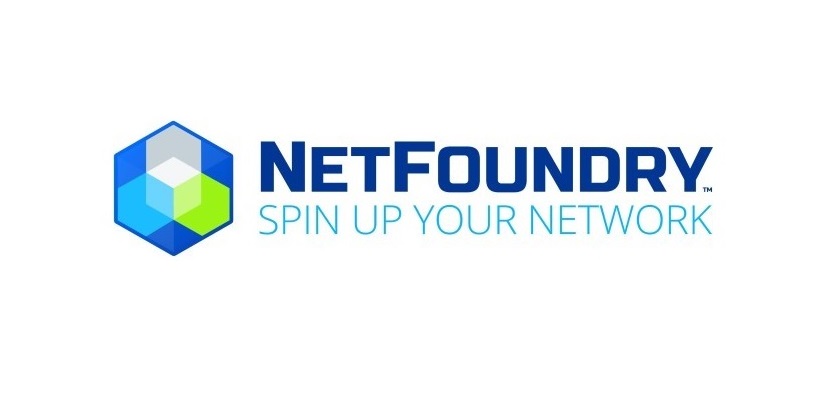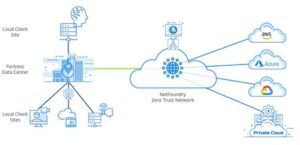
NetFoundry and Fortress Data introduce the first solution to enable end-to-end, cloud-based orchestration and delivery of edge and IoT applications, regardless of how many underlay networks and clouds they traverse.
The Universal Connected Compute Service simplifies networking, enabling Intelligent Edge application developers to innovate, and provides an operational structure built for the continuous compute paradigm in which apps are composed of distributed microservices, APIs and databases, with the workloads processed on compute spanning many edges and clouds.
Edge Computing is the extension of the cloud computing paradigm at the edges of the network. As the Linux Foundation’s LF Edge (LFE) organization outlines, “In essence, Edge Computing is distributed cloud computing, comprising multiple application components interconnected by a network.” 1
Cloud-native applications are becoming more dynamic and distributed as they leverage advances in Edge Computing and IoT sourced data, so a simple, extensible orchestration plane and delivery fabric which can provide network-agnostic control, security and quality is becoming critical to innovation of intelligent edge applications.
Modern Edge and IoT use cases where application response time and reliability is critical for success, requires compute, storage and networking capabilities to be as close as possible to the devices where data is generated and consumed. Determining the ideal edge location(s) to place these infrastructure resources involves multiple performance and economic variables across location(s), edge device compute, storage, and networking. Securing these distributed, heterogeneous compute environments requires zero trust security be inherently designed into the networking fabric – rather than trying to bolt on a collection of disparate technologies.
Fortress Data Centers and NetFoundry have teamed to provide the Universal Connected Compute Service. The Service provides instant, secure, performant, and scalable connectivity across edge and IoT app devices, Fortress Edge data centers, enterprise cores and public clouds by integrating NetFoundry’s zero trust Network-as-a-Service (NaaS) platform with Fortress’s edge data center capabilities.
Workloads are managed by a single cloud orchestrated set of policies and routing, regardless of all the underlying networks. Universal Connected Compute Service simplifies the implementation of advanced future leading-edge use cases such as augmented and virtual reality (AR and VR), artificial intelligence and machine learning (AI and ML), and spatial computing.
Here is an overview of how the NetFoundry – Fortress Data Centers’ Universal Connected Compute Service operates and its components and capabilities. Today’s advanced applications (IoT, AR/VR, AI/ML) are data-intensive – they push and pull data to and from devices at the Edge and to and from cloud(s), and to and from data centers. And all this needs to happen at incredible speeds.
These data push and pull scenarios typically include applications, compute, and networking combined into systems and sub-systems. This “system of systems” is then inter-connected to combinations of clouds, private data centers, mobile and wireless infrastructure. An example system of systems could look like this:
-
Applications running on an Edge device (e.g. VR headset, laptop, mobile phone) do some local processing and then automatically route data to low latency Edge compute at a local Fortress Data Center site.
- Often simultaneously, Edge applications are processing parts of the workload (e.g. video streaming and analysis) on local devices, parts running at servers at the Fortress site and parts running in clouds. NetFoundry provides zero trust security and low latency performance across this distributed compute environment, unifying all the routing, policies and controls into a single, cloud orchestrated management plane, regardless of the different underlay networks.
The NetFoundry – Fortress Data Centers’ solution thus creates a hybrid system which orchestrates workload processing across local, Edge, private data centers and cloud sites. This is the intelligent Edge; an interconnected Edge–Core–Cloud continuum that has exponential potential for delivering new innovation for IoT and Edge distributed applications.
This hybrid system is characterized as follows:
Universal compute continuum: This Service offering is designed to support distributed, dynamic, low latency applications that process workloads across IoT, edge, data centers and clouds – regardless of how many networks they traverse – with unified routing, policies, and controls.
Securely connected: Supporting applications operating in the Edge – Core – Cloud continuum requires a zero trust network access (ZTNA) paradigm. Legacy network security models based on carrier network boundaries, IP addresses, firewalls and VPNs simply can’t keep up with dynamic, borderless, distributed apps.
Low latency compute: Fortress Data Centers’ San Francisco site (Fortress SF1) provides high density, carrier neutral colocation and dense fiber interconnection designed for Edge operations. Fortress Data Centers offer 5G enabled Data Center Colocation space. The solution automatically routes local edge apps to SF1 for simple, automated, low latency compute access.
Simple as-a-service model: The solution offering is a turnkey service integrating Fortress Data Centers’ capabilities with NetFoundry’s zero trust network access, cloud orchestrated platform, delivered as Network-as-a-Service (NaaS). All the underlying network fabric is operated by NetFoundry. All the data center capabilities are operated by Fortress Data Centers. Our clients focus on designing, building, and implementing innovative applications and software.
The Universal Connected Compute Service from NetFoundry and Fortress Data Centers delivers continuous compute services for mission critical, low latency applications with strong security, and IoT and Edge computing. This joint solution enables our clients to drive innovation at scale by implementing emerging applications such as IoT, content delivery networks, AR/VR, AI/ML, gaming, video streaming, smart city, autonomous driving, blockchain, media and entertainment.
1 LF Edge paper: Sharpening the Edge: Overview of the LF Edge Taxonomy and Framework https://www.lfedge.org/wp-content/uploads/2020/07/LFedge_Whitepaper.pdf








